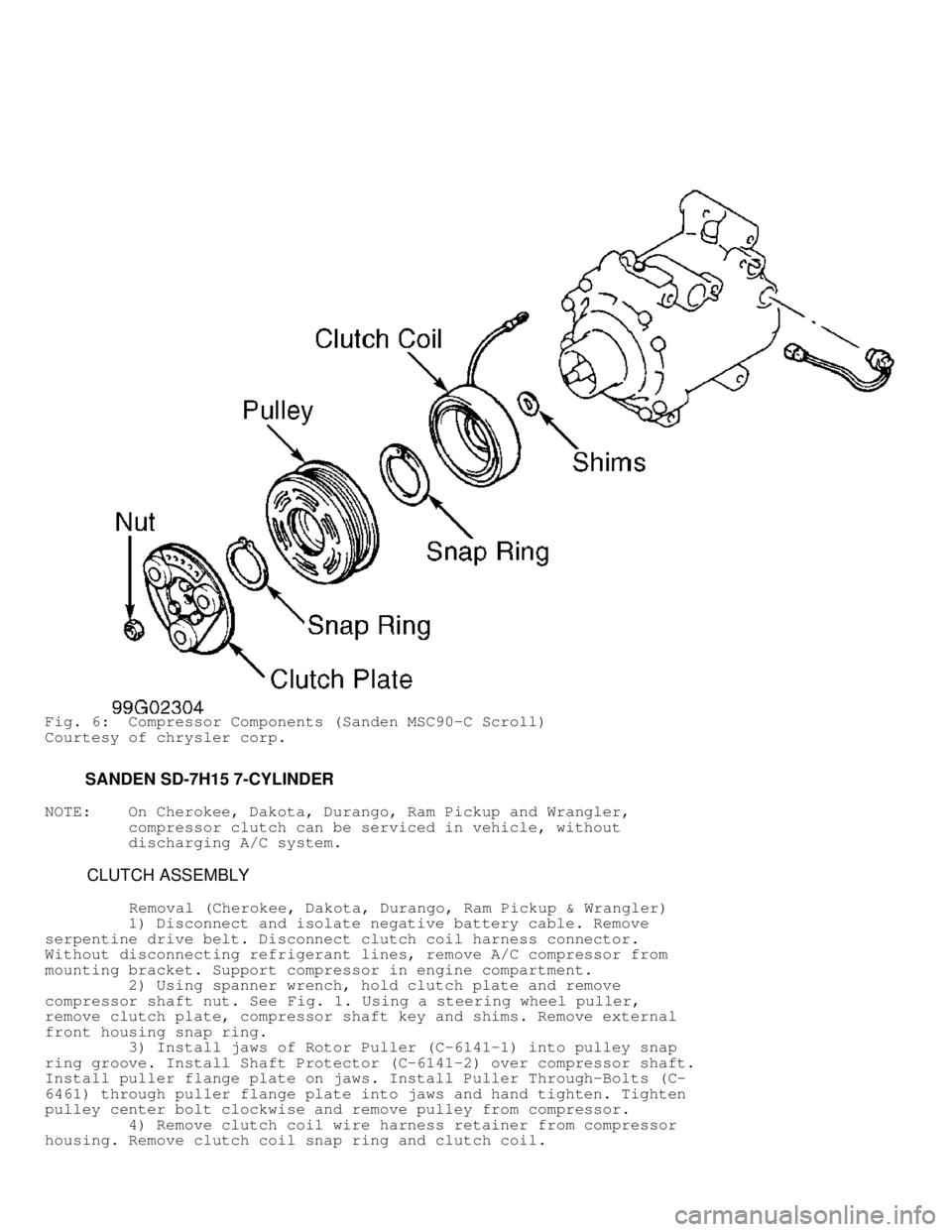1999 DODGE RAM steering
[x] Cancel search: steeringPage 8 of 1691

“O” ABBREVIATION TABLE (con’t) ABBREVIATION DEFINITION OHC Overhead Camshaft ORG Orange OSC Output State Check Opt. Option or Optional oz. Ounce ozs. Ounces
"P" ABBREVIATION TABLE
"P" ABBREVIATION TABLE
ABBREVIATION DEFINITION P Park P/C Printed Circuit P/N Park/Neutral P/S Power Steering PAV Pulse Air Valve PC-SOL Purge Control Solenoid PCM Powertrain Control module PCS Purge Control Solenoid PCSDM Passenger Compartment Sensor/Diagnostic Module PCV Positive Crankcase Ventilation PFE Pressure Feedback EGR sensor or circuit PFI Port Fuel Injection (see MA SEFI) PGM-CARB Programmed Carburetor PGM-FI Programmed Fuel Injection PIP Profile Ignition Pickup PNK Pink PPL Purple PRNDL Park Reverse Neutral Drive Low PROM Programmable Read-Only Memory psi Pounds Per Square Inch PSPS Power Steering Pressure Switch PTC Positive Temperature Coefficient PTO Power Take-Off PWR GND Power Ground circuit Pkg. Package Press. Pressure Prog. Programmed or Programmable Pts. Pints Pwr. Power
"Q" ABBREVIATION TABLE
"Q" ABBREVIATION TABLE
ABBREVIATION DEFINITION Qts.
Quarts
Page 9 of 1691

"R" ABBREVIATION TABLE
"R" ABBREVIATION TABLE
ABBREVIATION DEFINITION RABS Rear Anti-Lock Brake System RAC Remote Accessory Control RAM Random Access Memory RAP Retained Accessory Power RECIRC Recirculation RED Red RH Right hand ROM Read Only Memory RPM Revolutions Per Minute RVB Rear Vacuum Break RWAL Rear Wheel Anti-Lock Brake RWD Rear Wheel Drive Recirc. Recirculate or Recirculation Reg. Regulator Rly. Relay
"S" ABBREVIATION TABLE
"S" ABBREVIATION TABLE
ABBREVIATION DEFINITION SAW Spark Angle Word _ SBC Single Bed Converter _ SBEC Single Board Engine Controller _ SC Super Charged _ SCC Spark Control Computer _ SCS Air Suction Control Solenoid _ SDM Supplemental Restraint System Diagnostic Module _ SDU SRS Diagnostic Unit _ SEN Sensor _ SES Service Engine Soon _ SFI Sequential (Port) Fuel Injection _ SIG RTN Signal Return circuit _ SIL Shift Indicator Light _ SIR Supplemental Inflatable Restraint _ SMEC Single Module Engine Controller _ SOHC Single Overhead Cam _ SOL or SoL Solenoid _ SPFI Sequential Port Fuel Injection _ SPK Spark Control _ SPOUT Spark Output Signal _ SRS Supplemental Restraint System (Air Bag) _ SS 3/4-4/3 Shift Solenoid circuit _ SSI Solid State Ignition _ STAR Self-Test Automatic Readout _ STI Self Test Input circuit _ STO Self-Test Output _ SUB-O2 Sub Oxygen Sensor _ Sen. Or Sens. Sensor _ Sol. Solenoid _ Sprchg. Supercharger _ Strg. Steering _ Susp. Suspension _ Sw. Switch _ Sys. System _
Page 10 of 1691

"T" ABBREVIATION TABLE
"T" ABBREVIATION TABLE
ABBREVIATION DEFINITION T.V. Throttle Valve _ TAB Thermactor Air By-Pass _ TAC Thermostatic Air Cleaner _ TAD Thermactor Air Diverter _ TAN Tan _ TBI Throttle Body Injection _ TCC Torque Converter Clutch _ TCCS Toyota Computer Control System TDC Top Dead Center _ TDCL Total Diagnostic Communication TFI Thick Film Ignition system _ TGS Top Gear Switch (cancels SIL in THERMAC Thermostatic Air Cleaner _ THS Transmission Hydraulic Switch _ TP/TPS Throttle Position Sensor _ TPI Tuned Port Injection _ TPS Throttle Position Sensor/Switch TS Temperature Sensor _ TSB Technical Service Bulletin _ TTS Transmission Temperature Switch TV Thermovalve _ TWC Three-Way Catalyst _ Temp. Temperature _ Trans. Transaxle/Transmission _
"V" ABBREVIATION TABLE
"V" ABBREVIATION TABLE
ABBREVIATION DEFINITION V Valve _ VAF Vane Air Flow sensor or circuit _ VAPS Variable Assist Power Steering _ VAT Vane Air Temperature _ VATS Vehicle Anti-Theft System _ VBATT Vehicle Battery Voltage _ VCC Viscous Converter Clutch _ VIN Vehicle Identification Number _ VIO Violet _ VLR Volt Loop Reserve _ VM Vacuum Modulator _ VM Vane Meter _ VOM Volt-Ohmmeter (Analog) _ VPWR Vehicle Power supply voltage (10-14 VREF Voltage Reference (ECA supplied ref VRV Vacuum Regulator Valve _ VSC Vehicle Speed Control sensor or sign VSS Vehicle Speed Sensor or signal _ VSV Vacuum Switching Valve _ Vac. Vacuum _ Volt. Voltage _
Page 37 of 1691

Ford Motor Co. (Taurus 3.4L SHO)
1) Discharge A/C system, using approved refrigerant
recovery/recycling equipment. Remove A/C compressor. Drain and measure
oil from compressor.
2) Remove pulley assembly. Using Spanner Wrench (T81P-19623-
MH), remove shaft nut and lock washer. Using a steering wheel puller,
remove clutch plate, shaft key and shim. Remove snap ring and pulley
assembly, by hand. If necessary, use a 3-jaw puller to remove pulley
assembly. Remove clutch coil wire from retaining brace on compressor.
Remove snap ring and clutch coil. See Fig. 1.
Installation
1) Install clutch coil. Ensure hole on back of clutch coil is
aligned with pin on compressor head. Install snap ring with beveled
side facing outward. Install clutch coil wire into retaining brace.
2) Slip pulley assembly onto compressor shaft and install
snap ring with beveled side facing outward. Install shim and shaft
key. Align clutch plate with shaft key and install clutch plate. Use
Hub Driven Plate Replacer (T80L-19703-F), if necessary. Using spanner
wrench, install lock washer and shaft nut. Tighten shaft nut to 10-14
ft. lbs. (14-19 N.m).
3) Using a feeler gauge, measure air gap between clutch plate
and pulley assembly at 3 equally spaced locations. Rotate pulley 180
degrees and measure air gap at 3 locations again. Air gap should be 0.
016-0.027" (0.41-0.69 mm). If air gap is not within specification, add\
or remove shims to obtain correct air gap.
4) Add correct amount of refrigerant oil to compressor and
install compressor. See COMPRESSOR REFRIGERANT OIL CHECKING. Evacuate
and charge A/C system. Perform leak test.
SANDEN MSC90-C SCROLL
CLUTCH ASSEMBLY
Removal
1) Discharge A/C system, using approved refrigerant
recovery/recycling equipment. Remove compressor. Drain oil from
compressor, and measure amount drained.
2) Remove pulley assembly. Using Spanner (MB991367) and Pins\
(MB991386), remove shaft nut. Remove clutch plate, snap ring and rotor\
assembly. Remove snap ring and clutch coil. See Fig. 6.
Installation
1) Install clutch coil. Ensure projection on back of clutch
coil is aligned with pin hole in compressor body. Install snap ring so
that tapered surface is facing outward.
2) Install rotor assembly and snap ring. Align match mark of
clutch plate with match mark of compressor shaft spline and install
clutch plate. Using spanner and pins, install shaft nut.
3) Using a feeler gauge, check air gap between clutch plate
and rotor assembly at more than one place. Air gap should be 0.016-0.
024" (0.40-0.60 mm). If air gap is not within specification, add or
remove shims as necessary. Install pulley assembly.
4) Add same amount of refrigerant oil to compressor as was
drained from it. Install A/C compressor. Evacuate and charge A/C
system. Perform leak test.
Page 38 of 1691

Fig. 6: Compressor Components (Sanden MSC90-C Scroll)
Courtesy of chrysler corp.
SANDEN SD-7H15 7-CYLINDER
NOTE: On Cherokee, Dakota, Durango, Ram Pickup and Wrangler,
compressor clutch can be serviced in vehicle, without
discharging A/C system.
CLUTCH ASSEMBLY
Removal (Cherokee, Dakota, Durango, Ram Pickup & Wrangler)
1) Disconnect and isolate negative battery cable. Remove
serpentine drive belt. Disconnect clutch coil harness connector.
Without disconnecting refrigerant lines, remove A/C compressor from
mounting bracket. Support compressor in engine compartment.
2) Using spanner wrench, hold clutch plate and remove
compressor shaft nut. See Fig. 1. Using a steering wheel puller,
remove clutch plate, compressor shaft key and shims. Remove external
front housing snap ring.
3) Install jaws of Rotor Puller (C-6141-1) into pulley snap
ring groove. Install Shaft Protector (C-6141-2) over compressor shaft.\
Install puller flange plate on jaws. Install Puller Through-Bolts (C-
6461) through puller flange plate into jaws and hand tighten. Tighten
pulley center bolt clockwise and remove pulley from compressor.
4) Remove clutch coil wire harness retainer from compressor
housing. Remove clutch coil snap ring and clutch coil.
Page 39 of 1691

Installation (Cherokee & Wrangler)
1) Install clutch coil and clutch coil snap ring. Install
clutch coil wire harness to compressor housing. Align pulley and
bearing assembly on front compressor housing hub. Using Installer (C-
6871), press pulley and bearing assembly onto compressor housing hub.
Thread installer on compressor shaft and tighten nut until pulley
assembly is seated.
2) Install external front snap ring with beveled side facing
outward. Ensure snap ring is properly seated. Install compressor shaft
key and original shims. Using a plastic mallet and Driver (C-6463),
install clutch plate on compressor shaft. Tighten compressor shaft nut
to 10 ft. lbs. (14 N.m).
3) Using feeler gauge, measure air gap between clutch plate
and pulley assembly in several areas. Air gap should be 0.016-0.031"
(0.41-0.79 mm). If air gap is not within specification, adjust shim
thickness as necessary. If air gap is not consistent around clutch
plate, lightly pry up or tap down on clutch plate to make corrections.
To complete installation, reverse removal procedure.
Installation (Dakota, Durango & Ram Pickup)
1) Install clutch coil and clutch coil snap ring. Install
clutch coil wire harness to compressor housing. Align pulley and
bearing assembly on front compressor housing hub.
2) Install Handle (6464) and Driver (6143) into pulley
assembly bearing cavity. Ensure outer edge of driver rests firmly on
inner race of bearing. Using hammer, install pulley and bearing
assembly. While tapping on handle, guide pulley and bearing assembly
to prevent binding. Ensure pulley assembly bottoms against compressor
housing. Install external snap ring.
3) Install original shim(s) and compressor shaft key. Use a
hammer and Shaft Protector (6141-2) to install clutch plate on
compressor shaft. Ensure clutch plate bottoms out on clutch shims.
Replace compressor shaft nut and tighten compressor shaft nut to 10
ft. lbs. (14 N.m).
4) Measure air gap between clutch plate and pulley assembly
in several areas. Air gap should be 0.016-0.031" (0.41-0.79 mm). If
air gap is not within specification, adjust shim thickness as
necessary. If air gap is not consistent around clutch plate, lightly
pry up or tap down on clutch plate to make corrections. To complete
installation, reverse removal procedure. Ensure A/C system operates
properly.
5) After completing compressor clutch installation, start
engine. Set A/C-heater control to recirculated air mode and high
blower motor speed. Set engine speed to 1500-2000 RPM. Cycle
compressor on for 5 seconds and off for 5 seconds, about 20 times to
break-in clutch.
Removal (Ford "F" Series Super Duty Pickup)
1) Disconnect and isolate negative battery cable. Discharge
A/C system, using approved refrigerant recovery/recycling equipment.
Disconnect clutch coil harness connector and remove compressor. Drain
oil from compressor, and measure amount drained.
2) Using Spanner Wrench (T70P-4067-A), hold clutch plate and\
remove compressor shaft nut. See Fig. 1. If necessary, use a steering
wheel puller to remove clutch plate and shim(s).
3) Using a flat-blade screwdriver, remove pulley assembly
bearing dust cover. Remove compressor shaft key and internal bearing
snap ring. Remove external front housing snap ring.
4) Install jaws of rotor puller into pulley assembly internal
bearing snap ring groove. Install shaft protector over compressor
shaft. Install puller flange plate on jaws. Install 2 puller bolts
through puller flange plate into jaws and hand tighten. Tighten pulley
center bolt clockwise and remove pulley assembly from compressor.
Page 53 of 1691

HEATER HOSES
HIGH PRESSURE RELIEF VALVES (HPRV)
IDLERS
IN-LINE FILTERS
METAL FITTINGS
METAL LINES
MIX AND AIR CONTROL DOORS (BLEND DOORS)
O-RINGS
ORIFICE TUBES
PILOT-OPERATED ABSOLUTES (POAS)
PLENUMS
PRESSURE CONTROL VALVES
PRESSURE SENSORS
PULLEYS
RADIATORS
RECEIVER-DRIERS
REFRIGERANT
REFRIGERANT OIL
RELAYS
SEALS
SERVICE PORTS
SPRING LOCK COUPLINGS
SUCTION THROTTLING VALVES (STVS)
SWITCHES (ELECTRICAL)
TENSIONERS
THERMISTORS AND PRESSURE SENSORS
THERMOSTATS AND HOUSINGS
VACUUM HOSES AND TUBES
VACUUM RESERVOIRS
VACUUM TUBES
VALVES IN RECEIVER (VIRS)
WATER PUMPS (ELECTRIC AUXILIARY)
WIRING HARNESSES AND CONNECTORS
MOTORIST ASSURANCE PROGRAM (MAP)
OVERVIEW
The Motorist Assurance Program is the consumer outreach
effort of the Automotive Maintenance and Repair Association, Inc.
(AMRA). Participation in the Motorist Assurance Program is drawn from
retailers, suppliers, independent repair facilities, vehicle
manufacturers and industry associations.
Our organization's mission is to strengthen the relationship
between the consumer and the auto repair industry. We produce
materials that give motorists the information and encouragement to
take greater responsibility for their vehicles-through proper,
manufacturer-recommended, maintenance. We encourage participating
service and repair shops (including franchisees and dealers) to adopt
(1) a Pledge of Assurance to their Customers and (2) the Motorist
Assurance Program Standards of Service. All participating service
providers have agreed to subscribe to this Pledge and to adhere to the
promulgated Standards of Service demonstrating to their customers that
they are serious about customer satisfaction.
These Standards of Service require that an inspection of the
vehicle's (problem) system be made and the results communicated to the\
customer according to industry standards. Given that the industry did
not have such standards, the Motorist Assurance Program successfully
promulgated industry inspection communication standards in 1994-95 for
the following systems: Exhaust, Brakes, ABS, Steering and Suspension,
Engine Maintenance and Performance, HVAC, and Electrical Systems.
Further, revisions to all of these inspection communication standards
Page 54 of 1691

are continually republished. In addition to these, standards for Drive
Train and Transmissions have recently been promulgated. Participating
shops utilize these Uniform Inspection & Communication Standards as
part of the inspection process and for communicating their findings to
their customers.
The Motorist Assurance Program continues to work
cooperatively and proactively with government agencies and consumer
groups toward solutions that both benefit the customer and are
mutually acceptable to both regulators and industry. We maintain the
belief that industry must retain control over how we conduct our
business, and we must be viewed as part of the solution and not part
of the problem. Meetings with state and other government officials
(and their representatives), concerned with auto repair and/or
consumer protection, are conducted. Feedback from these sessions is
brought back to the association, and the program adjusted as needed.
To assure auto repair customers recourse if they were not
satisfied with a repair transaction, the Motorist Assurance Program
offers mediation and arbitration through MAP/BBB-CARE and other non-
profit organizations. MAP conducted pilot programs in twelve states
before announcing the program nationally in October, 1998. During the
pilots, participating repair shops demonstrated their adherence to the
Pledge and Standards and agreed to follow the UICS in communicating
the results of their inspection to their customers. To put some
"teeth" in the program, an accreditation requirement for shops was
initiated. The requirements are stringent, and a self-policing method
has been incorporated which includes the "mystery shopping" of
outlets.
We welcome you to join us as we continue our outreach... with
your support, both the automotive repair industry and your customers
will reap the benefits. Please visit MAP at our Internet site www.
motorist.org or contact us at:
1444 I Street, NW Suite 700
Washington, DC 20005
Phone (202) 712-9042 Fax (202) 216-9646
January 1999
MAP UNIFORM INSPECTION GENERAL GUIDELINES
OVERVIEW OF SERVICE REQUIREMENTS & SUGGESTIONS
It is MAP policy that all exhaust, brake, steering,
suspension, wheel alignment, drive-line, engine performance and
maintenance, and heating, ventilation and air conditioning, and
electrical services be offered and performed under the standards and
procedures specified in these sections.
Before any service is performed on a vehicle, an inspection
of the appropriate system must be performed. The results of this
inspection must be explained to the customer and documented on an
inspection form. The condition of the vehicle and its components will
indicate what services/part replacements may be "Required" or
"Suggested". In addition, suggestions may be made to satisfy the
requests expressed by the customer.
When a component is suggested or required to be repaired or
replaced, the decision to repair or replace must be made in the
customer's best interest, and at his or her choice given the options
available.
This section lists the various parts and conditions that
indicate a required or suggested service or part replacement.
Although this list is extensive, it is not fully inclusive. In
addition to this list, a technician may make a suggestion. However,
any suggestions must be based on substantial and informed experience,